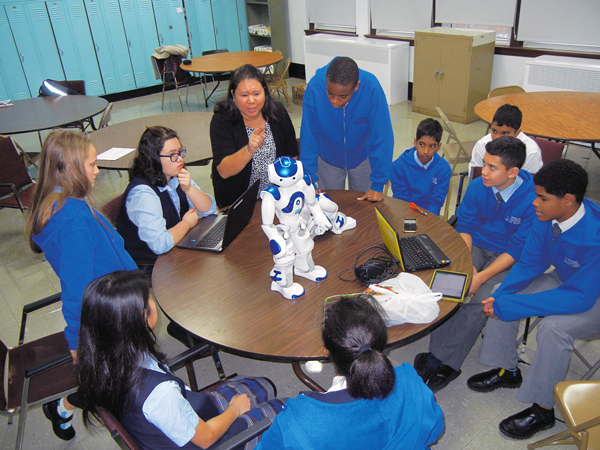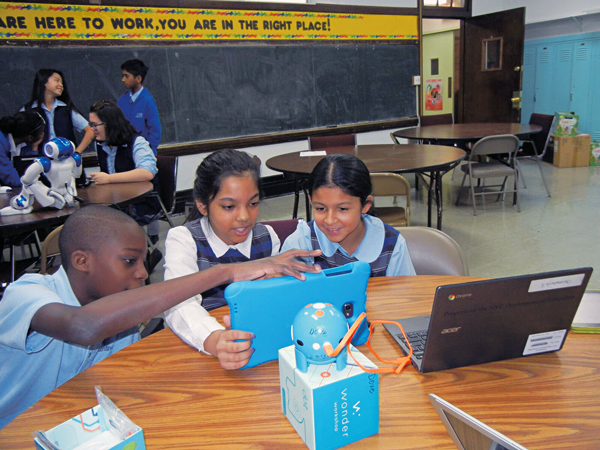by Melissa Enaje

On a dreary New York day, a classroom at St. Nicholas of Tolentine Catholic Academy, Jamaica, was anything but dull. Fifteen middle-school students crowded around two separate tables and were captivated by four peculiar gadgets: robots that were programmed by the students to sit, sing, do the Macarena dance and even recite the Our Father.
“We started the robotics program to enhance our STEM curriculum as it is essential for 21st-century learning,” said Robert Lowenberg, principal. “It is an opportunity to offer an enhanced program and ensure we offer the highest quality educational experience we can.”
Participants are chosen based on criteria consisting of academic performance, parental consent and teacher recommendations. For the full school year, the young engineers-in-training meet once a week for 45 minutes and work as a team to solve programming problems.
Animating Dot and Dove
The teams are separated by grade level, beginning with sixth graders who are introduced to basic computer programming skills that bring to life two wonder bots called Dot and Dove. The circular robots look more like the web cameras attached to the top of computer screens back when computers weren’t made with built-in cameras.
Except Dot and Dove don’t sit idle, but instead complete tasks assigned by their human counterparts. The assignment given to the two circular companions: to sing the notes of the tonal scale.

After three students, Rheanna Dancel, Vanessa Torretejo and Alonzo Rico push a variety of buttons on an electronic tablet, the dots on the screen start connecting and terminology unfamiliar to a regular ear starts being said and voilà – what looked like complicated geometry formulas became Dot singing through its speaker “Do, Re, Mi, Fa, So, La, Ti” while lighting up in red, green and blue hues. Watching Dot follow its directions are three smiling sixth graders.
For Alonzo Rico, this class plays a significant role since he wants to be a computer programmer when he grows up, just like his mother who works with computers.
“She said, ahh, I can’t wait until you get to the big robots,” said Rico when he describes the more advanced robots that the seventh- and eighth-grade students use. “She said I could do that anyway even if I’m in the sixth grade and I’m like, probably.”
The Nao Robots
The seventh and eighth graders combine to work on two more advanced, large doll-sized robots called the Nao Robots.
Jason Pharsi and Anik Amin sit behind a laptop with a screen showing what looks like drawings in an elementary anatomy class, with squares connected through scribbly lines to other squares that have prompts to move or talk.
But on the other side of the table are five girls who are actively interacting with the robot, jamming buttons on the other laptop while giggling as if they just opened new Barbie dolls on Christmas.
Except these were far from stereotypical girl-geared toys, they were blue and gray robots that spoke in a monotone voice and followed directions when prompted to. One Nao Robot would turn its neck and look at a person if it sensed someone was close to it because of the camera installed in its head.
“They’re learning the sequencing of everything and which goes where and they’re troubleshooting a lot which is really great,” said robotics class instructor and math teacher Mariella Reiman.
“So they’re actually pretty much on their own for the most part, with a little bit of guidance.”
But don’t be fooled, these students have a insatiable desire to create and solve, especially the girls in the class, who thrive on thinking out of the box when it comes to creating programs for the robots to follow.
The Macarena Dance
The popular ’90s line dance etitled “Macarena” by Los del Rio was a dance formation where people would line up and stick their arms out and then around their head, down to their hip and then turn. The girls in the classroom weren’t even born in the 1990s but programmed their Nao Robot to do similar dance moves to the song. Every arm movement and robotic hip shake was a calculated code that the girls created.
“I want to make my own robot because you can do so much. If you create it, you can add lasers,” said Katelin Chen. “Now there’s so many things like guns and violence, so my robot will protect me.
“I never knew that you could do it and I didn’t know as much as I do now, but now that I’ve been introduced to this new thing, I kind of want to make a robot.”
An Innovative Legacy
The two robots that the upper graders get to work on were actually donated by two friends of Principal Lowenberg.
“In their honor, we named the robots Rudy and Patty after them,” Lowenberg said.
The year when his friend Rudy helped fund the beginning stages of St. Nicholas of Tolentine’s robotics program was also the same year his friend unfortunately passed away.
But gauging by the amount of vibrant energy radiating in that classroom in Queens, it is safe to say Rudy and Patty will always hold a special place in the lives of these eager students who get a chance to walk through that classroom, sit down and let their creativity come to life, one coding idea after another.
